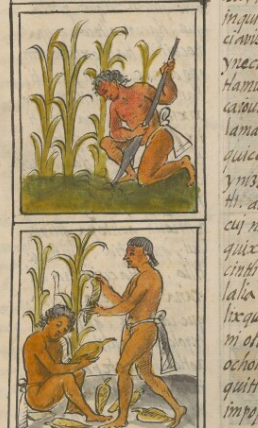elotl (FCbk4f72r)
This iconographic example of maize cultivation and fresh corn cobs coming off the stalk is included here for making potential comparisons with Nahuatl hieroglyphs and understanding their context. It comes from the Digital Florentine Codex, which has provided the keyword elotl for the corn cobs in this scene. The scene shows two men in loincloths, one standing and one sitting, both in a ¾ view. They face each other. The one that is sitting holds an ear of corn, while the other one seems to be harvesting. Additional elotes (the term in Mexican Spanish) lie around on the ground. The artist here has been influenced by European stylistics, providing shading for three-dimensionality and grounding.
Stephanie Wood
Xilotl and centli (also spelled cintli) are additional terms, something like elotl, that are found in Nahuatl hieroglyphs. They can also show ears of corn still on a stalk. See some examples below. The fact that Elotl was given as a personal name seems to underline its significance in the culture. It may also have something to do with the shape of a corn cob and the size and shape of the newborn who would be given this name.
Stephanie Wood
1577
Jeff Haskett-Wood
maíz, fresco, planta, comida
elo(tl), a fresh corn cob, https://nahuatl.wired-humanities.org/content/elotl
el elote
Stephanie Wood
Available at Digital Florentine Codex/Códice Florentino Digital, edited by Kim N. Richter and Alicia Maria Houtrouw, "Book 4: The Soothsayers", fol. 72r, Getty Research Institute, 2023. https://florentinecodex.getty.edu/en/book/4/folio/72r/images/c9fdb7a0-eb... Accessed 29 June 2025.
Images of the digitized Florentine Codex are made available under the following Creative Commons license: CC BY-NC-ND (Attribution-NonCommercial-NoDerivs 4.0 International). For print-publication quality photos, please contact the Biblioteca Medicea Laurenziana ([email protected]). The Library of Congress has also published this manuscript, using the images of the World Digital Library copy. “The Library of Congress is unaware of any copyright or other restrictions in the World Digital Library Collection. Absent any such restrictions, these materials are free to use and reuse.”








